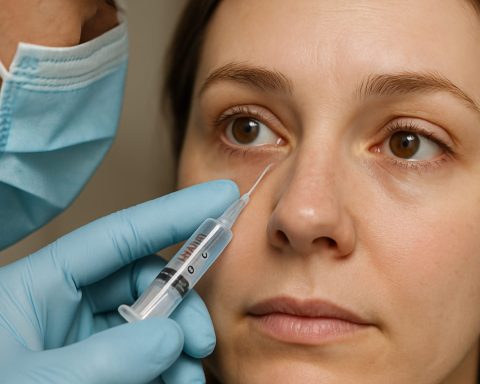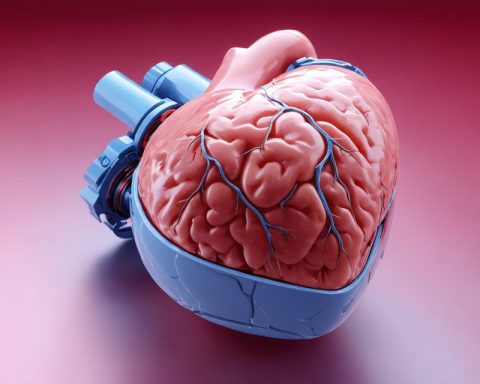Dacryocystography Explained: The Essential Imaging Technique for Diagnosing Lacrimal System Obstructions. Discover How This Procedure Transforms Patient Outcomes and Guides Treatment.
- Introduction to Dacryocystography
- Indications and Clinical Applications
- Procedure Overview and Imaging Techniques
- Interpretation of Dacryocystography Results
- Advantages and Limitations
- Comparative Analysis: Dacryocystography vs. Other Imaging Modalities
- Risks, Safety, and Patient Preparation
- Recent Advances and Future Directions
- Conclusion and Clinical Impact
- Sources & References
Introduction to Dacryocystography
Dacryocystography is a specialized radiographic technique used to visualize the lacrimal drainage system, particularly the lacrimal sac and nasolacrimal duct. This imaging modality plays a crucial role in the assessment of patients with epiphora (excessive tearing) or suspected obstruction within the lacrimal apparatus. By injecting a radiopaque contrast medium into the canaliculus, dacryocystography provides detailed anatomical and functional information, enabling clinicians to pinpoint the location and nature of blockages or structural abnormalities.
The procedure is typically indicated when non-invasive methods, such as clinical examination and lacrimal syringing, fail to clarify the cause of lacrimal outflow obstruction. Dacryocystography is particularly valuable in preoperative planning for dacryocystorhinostomy (DCR) and in the evaluation of complex or recurrent cases. It can differentiate between partial and complete obstructions, identify diverticula, fistulae, or masses, and assess postsurgical anatomy.
Advancements in imaging, including digital subtraction techniques and the integration of computed tomography (CT) or magnetic resonance imaging (MRI), have further enhanced the diagnostic yield of dacryocystography. Despite the emergence of alternative modalities such as dacryoscintigraphy and endoscopic evaluation, dacryocystography remains a gold standard for detailed anatomical assessment of the lacrimal drainage system. Its continued relevance is supported by guidelines from leading ophthalmic and radiological organizations, which emphasize its role in the comprehensive management of lacrimal disorders (American Academy of Ophthalmology, The Royal College of Radiologists).
Indications and Clinical Applications
Dacryocystography is primarily indicated for the evaluation of the lacrimal drainage system in patients presenting with symptoms such as epiphora (excessive tearing), recurrent dacryocystitis, or unexplained medial canthal swelling. It is particularly valuable when non-invasive tests, such as syringing and probing, yield inconclusive results or when surgical intervention is being considered. The technique allows for detailed visualization of the lacrimal sac, canaliculi, and nasolacrimal duct, enabling precise localization and characterization of obstructions, strictures, or fistulas within the system. This is crucial in differentiating between pre-saccular, saccular, and post-saccular blockages, which directly influences the choice of surgical or medical management.
In addition to its diagnostic role, dacryocystography is also used in the preoperative assessment and postoperative follow-up of patients undergoing procedures such as dacryocystorhinostomy (DCR) or lacrimal stenting. It helps assess the patency of the newly created passage and detect complications such as restenosis or false passages. Furthermore, the modality can be employed in the evaluation of congenital anomalies of the lacrimal system, traumatic injuries, and suspected neoplastic processes affecting the lacrimal sac or duct. In pediatric populations, it assists in distinguishing between congenital nasolacrimal duct obstruction and other causes of persistent tearing.
Overall, dacryocystography remains an essential tool in the armamentarium of ophthalmologists and radiologists, guiding both diagnosis and management of lacrimal drainage disorders, as highlighted by the American Academy of Ophthalmology and the Royal College of Radiologists.
Procedure Overview and Imaging Techniques
Dacryocystography is a specialized radiographic technique used to visualize the lacrimal drainage system, particularly the nasolacrimal duct and lacrimal sac, to diagnose obstructions or anatomical abnormalities. The procedure typically begins with the topical administration of a local anesthetic to the conjunctival sac, followed by the gentle cannulation of the lower or upper punctum using a fine lacrimal cannula. A radiopaque contrast medium is then slowly injected into the lacrimal drainage system. Fluoroscopic or conventional radiographic images are acquired in multiple projections, most commonly the posteroanterior and lateral views, to track the flow of contrast and delineate the site and nature of any obstruction or abnormality.
Modern dacryocystography may utilize digital subtraction techniques to enhance image clarity and reduce superimposition of bony structures. In some centers, computed tomography (CT) dacryocystography or magnetic resonance (MR) dacryocystography are employed for more detailed anatomical assessment, especially in complex or recurrent cases. These advanced modalities provide multiplanar imaging and superior soft tissue contrast, aiding in the evaluation of associated pathologies such as tumors or trauma-related changes. The choice of imaging technique depends on clinical indications, patient factors, and available resources. Dacryocystography remains a valuable diagnostic tool, particularly when non-invasive methods such as dacryoscintigraphy or clinical probing yield inconclusive results RadiologyInfo.org American Academy of Ophthalmology.
Interpretation of Dacryocystography Results
Interpreting dacryocystography (DCG) results requires a systematic evaluation of the lacrimal drainage system’s anatomy and function as visualized on radiographic images. The primary goal is to identify the site, nature, and extent of any obstruction or abnormality within the nasolacrimal pathway. Radiologists assess the opacification pattern of the contrast medium, noting whether it flows freely from the puncta through the canaliculi, lacrimal sac, and nasolacrimal duct into the inferior meatus. A normal study demonstrates uninterrupted passage of contrast without retention or reflux.
Obstructions are classified based on their location: pre-sac (canalicular), sac, or post-sac (nasolacrimal duct). A sudden cutoff of contrast suggests a complete obstruction, while delayed passage or narrowing indicates partial stenosis. Reflux of contrast into the opposite canaliculus or punctum may point to a functional or anatomical blockage at the common canaliculus or sac. The presence of diverticula, fistulae, or abnormal outpouchings can also be detected. Chronic inflammation may manifest as irregular sac outlines or mucosal thickening, while tumors or stones appear as filling defects within the contrast column.
Interpretation should always be correlated with clinical findings and, when necessary, adjunctive tests such as dacryoscintigraphy or endoscopic evaluation. Accurate reading of DCG is crucial for guiding surgical planning, such as dacryocystorhinostomy, and for predicting prognosis. For further guidance on interpretation standards, refer to resources from the Royal College of Radiologists and the American Academy of Ophthalmology.
Advantages and Limitations
Dacryocystography (DCG) offers several advantages in the evaluation of the lacrimal drainage system. One of its primary strengths is its ability to provide detailed anatomical visualization of the nasolacrimal duct and associated structures, allowing for precise localization of obstructions or strictures. This is particularly valuable in cases where clinical examination and non-invasive imaging are inconclusive. DCG is also useful in preoperative planning, helping surgeons determine the most appropriate intervention for patients with complex lacrimal disorders. Additionally, it can differentiate between functional and anatomical blockages, which is essential for tailoring patient management strategies American Academy of Ophthalmology.
However, DCG has notable limitations. The procedure is invasive, requiring cannulation of the lacrimal punctum and injection of contrast material, which can cause discomfort and carries a small risk of infection or allergic reaction. Radiation exposure, though minimal, is another consideration, especially in pediatric or pregnant patients. Furthermore, DCG primarily assesses the anatomical patency of the lacrimal system and may not fully evaluate functional disorders, such as those caused by abnormal tear dynamics without a structural blockage. Interpretation of images requires expertise, and false negatives can occur if the obstruction is intermittent or partial. As newer, less invasive imaging modalities like dacryoscintigraphy and CT dacryocystography become more available, the role of traditional DCG is evolving RadiologyInfo.org.
Comparative Analysis: Dacryocystography vs. Other Imaging Modalities
Dacryocystography (DCG) is a specialized radiographic technique used to visualize the lacrimal drainage system, particularly in cases of suspected obstruction or anatomical anomalies. When compared to other imaging modalities such as computed tomography (CT), magnetic resonance imaging (MRI), and dacryoscintigraphy, DCG offers unique advantages and limitations. DCG provides high-resolution, direct visualization of the lacrimal sac and nasolacrimal duct by injecting a contrast medium, making it particularly effective for identifying the precise location and nature of obstructions or strictures. In contrast, CT and MRI offer broader anatomical context, allowing assessment of adjacent structures and detection of mass lesions or inflammatory changes, but they lack the fine detail of the ductal lumen provided by DCG RadiologyInfo.org.
Dacryoscintigraphy, a nuclear medicine technique, evaluates the functional aspect of tear drainage by tracking radiotracer movement, but it is less effective in pinpointing anatomical abnormalities. Ultrasonography, while non-invasive, is limited in its ability to delineate the entire lacrimal drainage pathway. DCG remains the gold standard for preoperative planning in cases of nasolacrimal duct obstruction, especially when surgical intervention is considered American Academy of Ophthalmology. However, its invasive nature and exposure to ionizing radiation are notable drawbacks compared to non-invasive modalities. Ultimately, the choice of imaging depends on the clinical scenario, with DCG favored for detailed ductal assessment and other modalities providing complementary anatomical or functional information.
Risks, Safety, and Patient Preparation
Dacryocystography, while generally considered a safe and minimally invasive imaging technique for evaluating the lacrimal drainage system, does carry certain risks and requires specific patient preparation to ensure optimal outcomes. The primary risks associated with dacryocystography include allergic reactions to the iodinated contrast medium, infection, and, rarely, trauma to the lacrimal apparatus. Allergic reactions are uncommon but can range from mild skin rashes to severe anaphylactic responses; thus, a thorough allergy history, especially regarding iodine or contrast agents, is essential prior to the procedure. Infection risk is minimized by adhering to strict aseptic techniques during cannulation and contrast injection. Mechanical trauma, such as canalicular or ductal perforation, is rare but can occur, particularly in patients with pre-existing inflammation or anatomical abnormalities RadiologyInfo.org.
Patient preparation involves several key steps. Patients should be informed about the procedure, its purpose, and potential risks. A detailed medical history, including allergies and previous reactions to contrast media, should be obtained. Topical anesthesia is typically administered to minimize discomfort during cannulation of the lacrimal punctum. In some cases, prophylactic antibiotics may be considered, especially if there is a history of recurrent infections. Patients are usually advised to remove contact lenses and avoid eye makeup on the day of the procedure. Post-procedural care includes monitoring for signs of infection, allergic reaction, or persistent discomfort, and patients should be provided with clear instructions on when to seek medical attention American Academy of Ophthalmology.
Recent Advances and Future Directions
Recent advances in dacryocystography have significantly enhanced the diagnostic accuracy and patient experience in the evaluation of lacrimal drainage disorders. Traditional dacryocystography, which relies on iodinated contrast and conventional radiography, is increasingly being supplemented or replaced by newer imaging modalities. Digital subtraction dacryocystography offers improved visualization of the lacrimal system by digitally removing background structures, thus providing clearer images of subtle obstructions or anatomical variations. Additionally, the integration of computed tomography (CT) and magnetic resonance imaging (MRI) with dacryocystography—known as CT-DCG and MR-DCG—enables three-dimensional assessment and superior soft tissue contrast, which is particularly valuable in complex or recurrent cases and in preoperative planning American Academy of Ophthalmology.
The use of non-iodinated, water-soluble contrast agents and low-dose imaging protocols has also reduced the risk of adverse reactions and radiation exposure, making the procedure safer for a broader patient population. Furthermore, the advent of dynamic dacryocystography, which captures real-time flow of contrast through the lacrimal system, allows for functional assessment in addition to anatomical evaluation RadiologyInfo.org.
Looking ahead, artificial intelligence (AI) and machine learning algorithms are being explored to automate image interpretation and enhance diagnostic precision. These technologies hold promise for standardizing reporting and potentially identifying subtle pathologies that may be overlooked by human observers. As imaging technology continues to evolve, future directions in dacryocystography are likely to focus on further minimizing invasiveness, improving image resolution, and integrating multimodal data for comprehensive lacrimal system assessment National Center for Biotechnology Information.
Conclusion and Clinical Impact
Dacryocystography remains a valuable diagnostic tool in the evaluation of lacrimal drainage system disorders, particularly in cases of unexplained epiphora, recurrent dacryocystitis, or suspected anatomical obstruction. Its ability to provide detailed anatomical visualization of the lacrimal sac and nasolacrimal duct allows clinicians to accurately localize obstructions, differentiate between partial and complete blockages, and identify associated pathologies such as diverticula or fistulae. This precision is crucial for guiding appropriate management strategies, including surgical planning for procedures like dacryocystorhinostomy or balloon dacryoplasty. Furthermore, dacryocystography can be instrumental in assessing postoperative outcomes and detecting complications or recurrences, thereby contributing to improved patient care and prognosis.
Despite the advent of non-invasive imaging modalities such as dacryoscintigraphy and computed tomography (CT) dacryography, conventional dacryocystography continues to offer unique advantages, particularly in its high spatial resolution and direct visualization of the contrast flow dynamics. However, clinicians must weigh the benefits against potential risks, such as contrast reactions or radiation exposure, and consider patient-specific factors when selecting the most appropriate imaging technique. Ultimately, the integration of dacryocystography into the diagnostic algorithm enhances the clinician’s ability to deliver targeted, effective interventions for lacrimal system disorders, underscoring its enduring clinical impact in ophthalmology and otolaryngology practice (American Academy of Ophthalmology; RadiologyInfo.org).














